One of the great Renaissance Artists is Sandro Botticelli. Along with Leonardo da Vinci, Michelangelo, and Raphael, Botticelli is considered one of the greatest artists of the Renaissance.
The Renaissance was a period of artistic, cultural, and intellectual revival in Europe, roughly from the 14th to the 17th century. Among the many artists who emerged during this time, Sandro Botticelli stands out as a key figure whose work encapsulated the spirit and aesthetics of the period. Read on as we delve into Botticelli’s life, the reasons for his significance, and an exploration of his most important works.
Table of Contents
- Who Is The Artist Sandro Botticelli?
- 10 Reasons Why Sandro Botticelli Is A Significant Artist
- Mastery of Line and Detail
- Iconic Representation of Mythology
- Integration of Pagan and Christian Themes
- Emotional Expressiveness
- Patronage of the Medici Family
- Contribution to Portrait Art
- Influence on Later Art and Culture
- Symbolic Use of Nature and Landscape
- Technical Innovation
- Religious Devotion and Moral Themes
- 10 Most Important Works of Art and Their Significance
- The Birth of Venus (c. 1484–1486)
- Primavera (c. 1482)
- The Adoration of the Magi (c. 1475)
- Venus and Mars (c. 1483)
- Madonna of the Magnificat (c. 1481)
- The Calumny of Apelles (c. 1494–1495)
- Pallas and the Centaur (c. 1482)
- Mystic Nativity (c. 1500)
- Portrait of a Young Woman (c. 1480–1485)
- St. Augustine in His Study (c. 1480)
- Listen To Our Podcast About Why Is Sandro Botticelli Considered a Renaissance Master? Below or By clicking here.
- Related Questions
Who Is The Artist Sandro Botticelli?
Although Botticelli may not be as well-known as some other Renaissance artists, he is still a significant figure from that era. It would be worthwhile to delve deeper into his life and contributions.

Early Life And Background
Alessandro di Mariano di Vanni Filipepi, better known as Sandro Botticelli, was born around 1445 in Florence, Italy. He was the youngest of four children in a relatively modest family. His tanner father wanted him to pursue a trade, but Botticelli showed an early aptitude for the arts. He apprenticed with the renowned painter Fra Filippo Lippi, who significantly influenced his style.
Botticelli’s Career And Artistic Development
Botticelli’s career began in Florence, a hub of Renaissance activity. His work was marked by linear grace, delicate color, and ethereal beauty. He gained the patronage of the powerful Medici family, which was crucial to his success. Under their patronage, Botticelli created some of his most famous works, blending classical mythology with Christian themes.
Later Years And Legacy
Despite his success, Botticelli’s later years were marked by a decline in popularity as the High Renaissance artists like Michelangelo and Raphael emerged. He died in 1510, largely forgotten until the 19th century, when his work was rediscovered and celebrated for its beauty and emotional depth.
10 Reasons Why Sandro Botticelli Is A Significant Artist
Here are our top 10 reasons why Botticelli is a crucial Renaissance artist.
Mastery of Line and Detail
Botticelli’s use of line is unparalleled. His paintings are characterized by fluid, graceful lines that define the delicate forms of his subjects. This mastery of line work is evident in his paintings’ intricate details of the human figures, fabrics, and natural elements.
Iconic Representation of Mythology
Botticelli was among the first Renaissance artists to revive classical mythology in his work. His paintings often depict scenes from Greek and Roman mythology infused with a humanistic perspective, a significant departure from the strictly religious themes that dominated medieval art.
Integration of Pagan and Christian Themes
He adeptly blended pagan and Christian elements, reflecting the Renaissance’s broader intellectual movement. This synthesis is seen in works like “The Birth of Venus” and “Primavera,” where mythological figures coexist with symbolic Christian elements.
Emotional Expressiveness
Botticelli’s characters are often imbued with a deep sense of emotion and introspection. His ability to convey complex human emotions, from joy to melancholy, adds profound meaning to his work.
Patronage of the Medici Family
Being a favored artist of the Medici family, one of the most influential families in Renaissance Florence, Botticelli enjoyed significant support and commissions. This patronage elevated his status and provided him with the resources and inspiration to create his masterpieces.
Contribution to Portrait Art
Botticelli contributed significantly to the development of portraiture. His portraits are notable for their attention to the psychological aspects of the sitter, moving beyond mere representation to capture the personality and mood of the subject.
Influence on Later Art and Culture
Botticelli’s work has had a lasting influence on art and culture. His revival in the 19th century inspired the Pre-Raphaelite Brotherhood, and his style continues to influence contemporary art.
Symbolic Use of Nature and Landscape
His paintings often feature beautifully rendered landscapes and natural elements, which are not mere backgrounds but integral to the narrative and symbolism of the works. This careful attention to nature reflects the Renaissance interest in the natural world.
Technical Innovation
Botticelli experimented with techniques such as tempera on canvas and innovative methods of layering paint. His technical skills allowed him to achieve delicate color variations and detailed textures, contributing to the lifelike quality of his work.
Religious Devotion and Moral Themes
Despite his involvement with pagan themes, Botticelli’s work also reflects his deep religious faith and moral concerns. His later works, influenced by the Dominican friar Savonarola, depict a more reflective and melancholy religious vision, showing his versatility and depth as an artist.
10 Most Important Works of Art and Their Significance
Sandro Botticelli created numerous remarkable works of art. Here are 10 of his most significant paintings.
The Birth of Venus (c. 1484–1486)
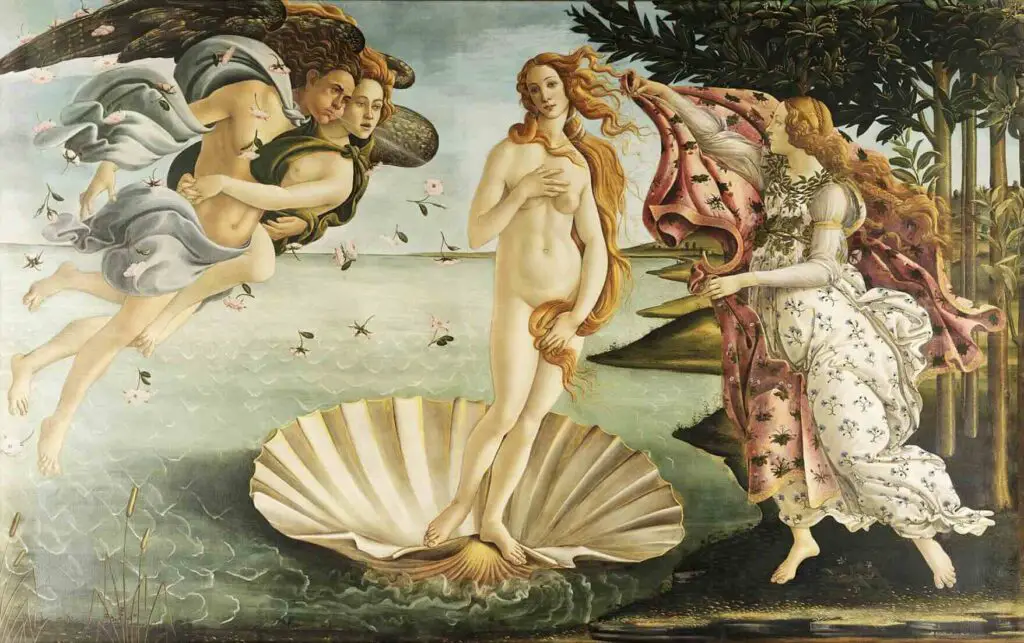
One of Botticelli’s most iconic paintings, “The Birth of Venus,” depicts the goddess Venus emerging from the sea on a shell. This work is celebrated for its graceful composition, Venus’s ethereal beauty, and use of mythological themes. The painting celebrates beauty and love, symbolizing the Renaissance’s revival of classical ideals.
Significance: “The Birth of Venus” is significant not only for its artistic qualities but also for its cultural impact. It represents the humanistic values of the Renaissance, celebrating the beauty of the human form and the natural world. The painting’s influence extends beyond art, inspiring literature, fashion, and popular culture.
Primavera (c. 1482)
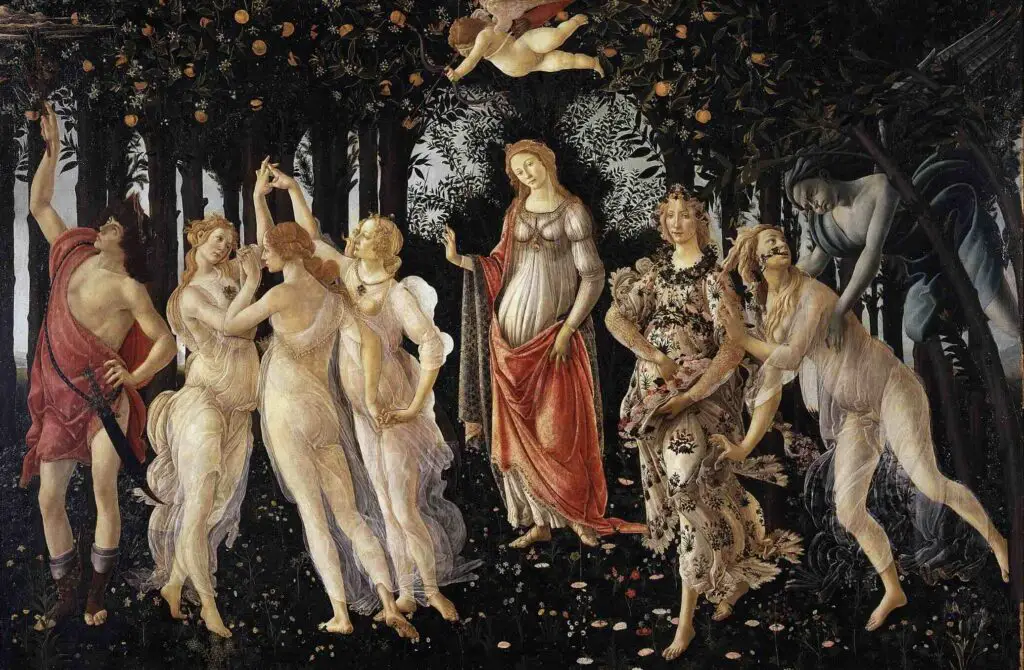
“Primavera” is another masterpiece that features a symbolic scene filled with mythological figures. The painting includes Venus, Mercury, the Three Graces, and other deities in a lush garden. The exact meaning of the painting remains debated, but it is often interpreted as an allegory of spring and the renewal of life.
Significance: “Primavera” is a prime example of Botticelli’s skill in combining complex allegorical content with exquisite beauty. The painting’s rich symbolism, intricate details, and harmonious composition make it a cornerstone of Renaissance art. It also reflects the Medici’s cultural influence, as it was likely commissioned for Lorenzo di Pierfrancesco de Medici.
The Adoration of the Magi (c. 1475)
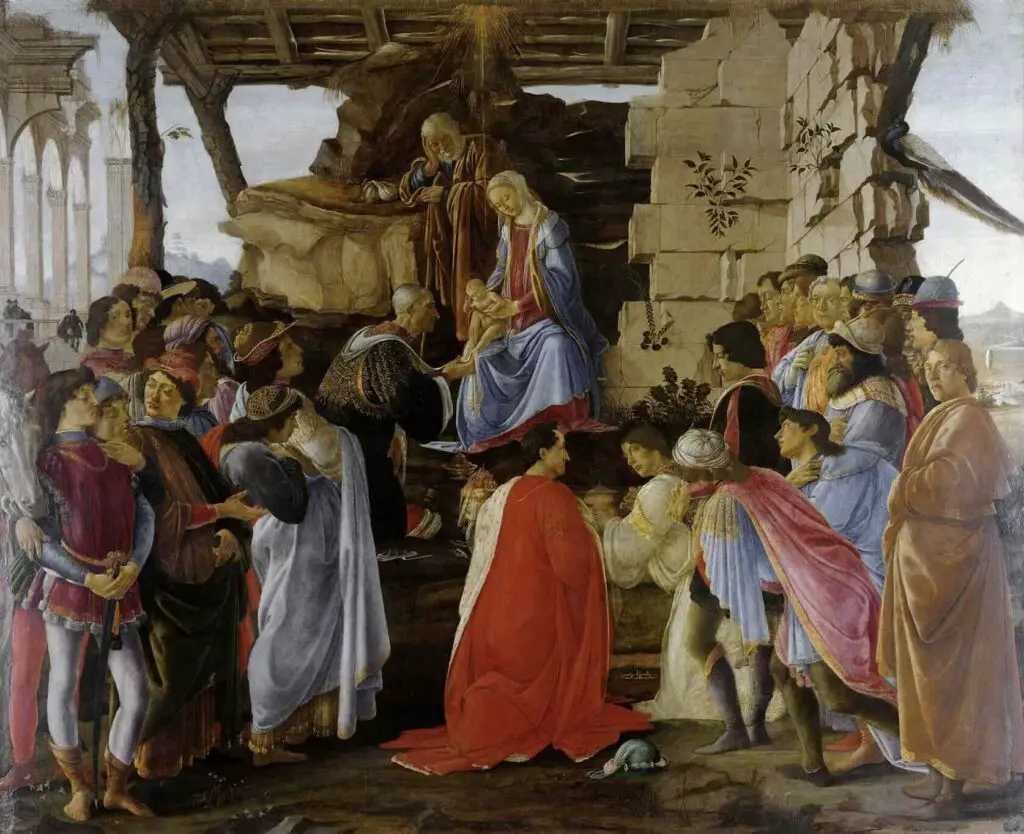
This painting portrays the biblical scene of the Magi paying homage to the newborn Christ. Botticelli’s version is notable for including portraits of members of the Medici family among the Magi and other figures. The composition is balanced, with a focus on the central figure of the Virgin Mary holding the Christ Child.
Significance: “The Adoration of the Magi” showcases Botticelli’s ability to blend religious themes with contemporary portraiture. It also demonstrates his talent for creating complex compositions with individual characters, each rendered with distinct features and expressions. The work highlights the close relationship between the Medici family and the artist.
Venus and Mars (c. 1483)
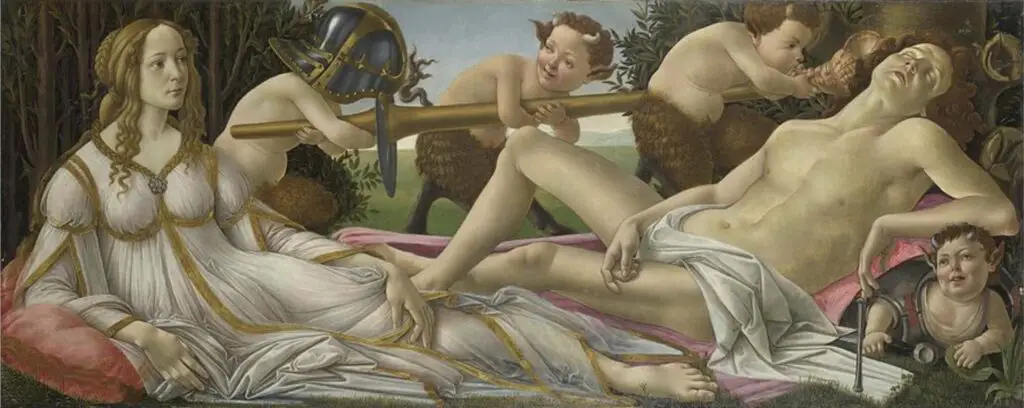
In “Venus and Mars,” Botticelli depicts the Roman gods Venus and Mars in a scene that symbolizes the contrast between love and war. Venus reclines calmly while Mars appears to be in a deep sleep, suggesting the power of love to bring peace. The painting is rich in symbolism, with satyrs playing with Mars’s armor in the background.
Significance: This work is notable for exploring the themes of love and harmony versus chaos and conflict. The sensual yet serene portrayal of Venus reflects the Renaissance idealization of feminine beauty. The painting’s allegorical nature allows for various interpretations, making it a subject of enduring interest.
Madonna of the Magnificat (c. 1481)

This tondo (circular painting) depicts the Virgin Mary and the Christ Child surrounded by angels. Mary is in the act of writing the Magnificat, a hymn of praise. The composition is elegant, focusing on the serene expressions of Mary and the Christ Child.
Significance: “Madonna of the Magnificat” is a beautiful example of Botticelli’s religious art. The delicate rendering of the figures and the use of gold leaf in the halos create a luminous effect. The painting reflects the Renaissance’s reverence for the Virgin Mary and the importance of holy images in public and private worship.
The Calumny of Apelles (c. 1494–1495)
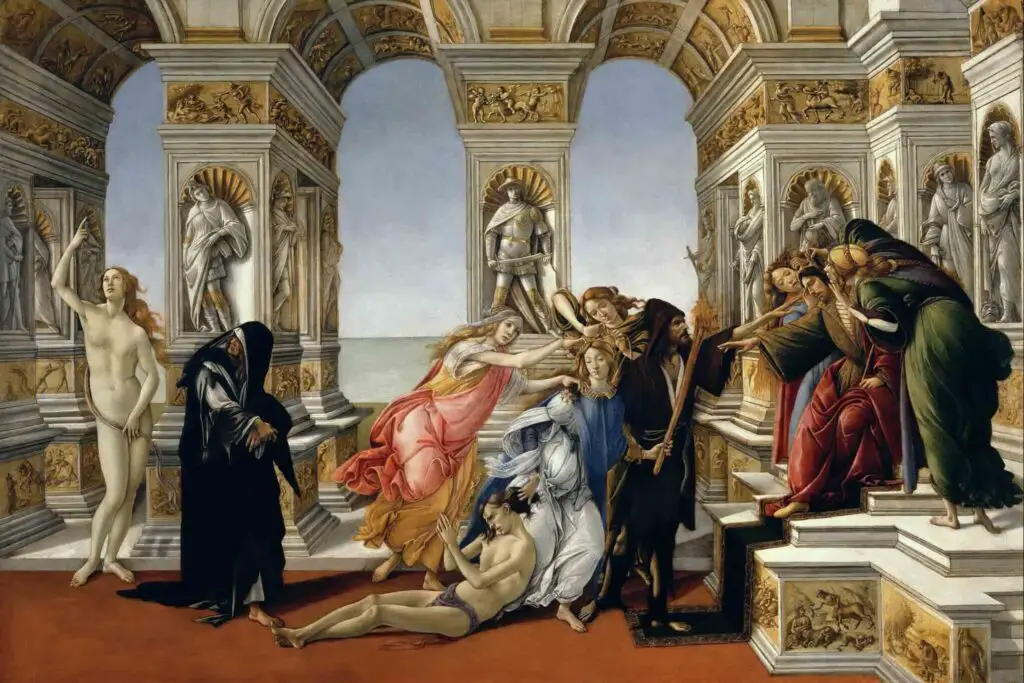
Inspired by a lost ancient painting described by Lucian, “The Calumny of Apelles” depicts a symbolic scene where Innocence is unjustly accused. The painting contains symbolic figures, including Calumny, Envy, and Truth. The work is notable for its complex composition and its moral message.
Significance: This painting powerfully explores the themes of truth and falsehood, justice and injustice. It reflects Botticelli’s engagement with humanist thought and his ability to convey complex philosophical ideas through visual art. The work is also an example of his later style, which became more somber and reflective.
Pallas and the Centaur (c. 1482)

This painting depicts the goddess Pallas Athena restraining a centaur, symbolizing the triumph of reason and wisdom over brute force and lust. The composition is dynamic, with Pallas appearing calm and composed while the centaur shows signs of struggle.
Significance: “Pallas and the Centaur” is an allegory of the victory of intellect over base instincts, a theme that resonated with Renaissance humanist ideals. The painting is celebrated for its expressive figures and the symbolic use of mythological elements. It also reflects Botticelli’s skill in creating narrative through gesture and expression.
Mystic Nativity (c. 1500)
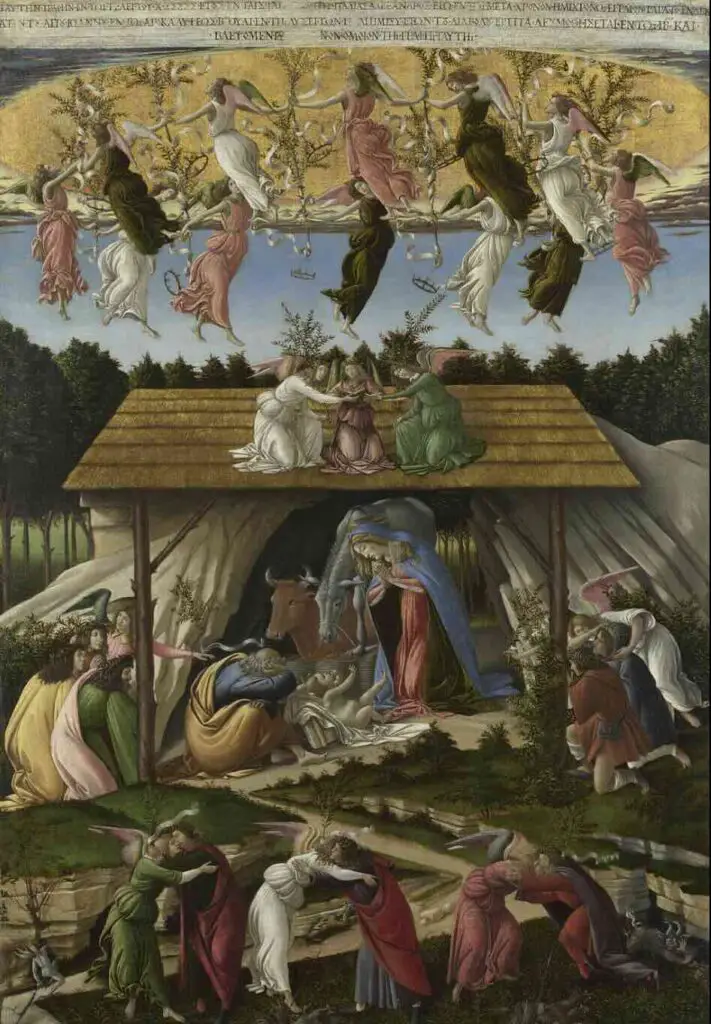
“The Mystic Nativity” is a unique interpretation of the Nativity scene, filled with symbolic elements. Angels celebrate the birth of Christ, while demons flee into the underworld. The painting also includes an inscription that references the political and religious turmoil of the time.
Significance: This work is significant for its apocalyptic vision and the incorporation of contemporary concerns into a religious narrative. It reflects Botticelli’s deepening religious fervor and his response to the influence of Savonarola, a preacher who condemned the moral corruption of Florence. The painting’s unique style and symbolism make it a fascinating study in Botticelli’s oeuvre.
Portrait of a Young Woman (c. 1480–1485)

This portrait is believed to depict Simonetta Vespucci, one of the most beautiful women of the Renaissance. It is notable for its elegance and grace, and the woman is portrayed with Botticelli’s characteristic delicate lines and soft coloration.
Significance: Botticelli’s portraits are celebrated for their ability to capture the sitter’s beauty and individuality. This particular work exemplifies the Renaissance ideal of feminine beauty and the artist’s skill in portraiture. It also reflects the cultural importance of individualism and personal identity during the Renaissance.
St. Augustine in His Study (c. 1480)
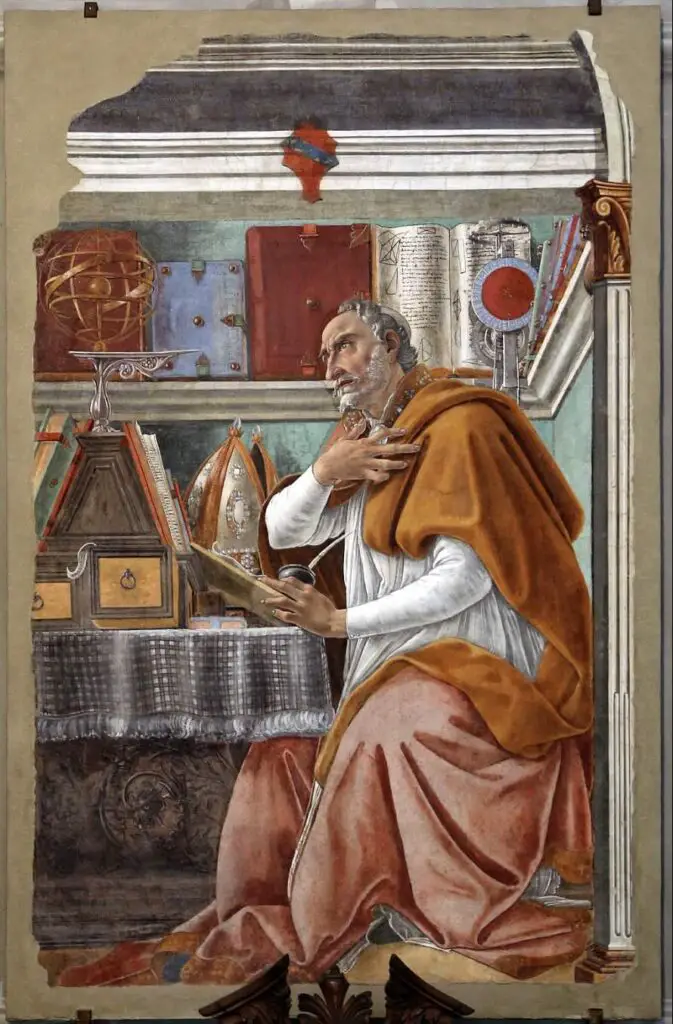
This fresco in the Church of Ognissanti in Florence depicts St. Augustine in deep contemplation in his study. The work is notable for its detailed depiction of the saint’s surroundings, filled with books and scholarly objects.
Significance: The fresco reflects Botticelli’s ability to convey intellectual depth and spiritual introspection. It also showcases his skill in fresco painting, a medium that requires a different technique and approach compared to panel painting. The work is an essential example of religious art in the context of Renaissance humanism.
Sandro Botticelli’s contribution to the art world is immeasurable. His unique blend of classical mythology, Christian iconography, and humanist ideals set him apart as one of the great masters of the Renaissance. Through his mastery of line, detail, and emotional expressiveness,
Botticelli created works that continue to captivate and inspire audiences today. His paintings reflect the cultural and intellectual currents of his time and offer timeless insights into the human condition. As we continue to explore and appreciate his art, Botticelli’s legacy remains a vital part of our artistic heritage.
Listen To Our Podcast About
Why Is Sandro Botticelli Considered a Renaissance Master? Below or By clicking here.

Anita Louise Art is dedicated to art education, great artists, and inspiring others to find and create their art. We love art that uplifts and inspires. #ArtToMakeYouSmile! #ArtToMakeYouHappy!
If you are interested to see any of my art, you can find out more by clicking here. If you are interested in what inspires me and my paintings, you can discover more by clicking here.
We have a free newsletter and would love you to be part of our community; you can subscribe to the newsletter by clicking here. If you have any questions, I would be happy to talk to you anytime. You can reach me, Anita, by clicking here.
Subscribe to our Anita Louise Art YouTube Channel with great videos and information by clicking here.
Related Questions
Is Art An Natural Gift, Or Can Anyone Be Good At Art If They Practice?
Most artists have some natural gift or desire to be an artist. But iheir education, hard work, practice, and association with other artists take all the difference. Having a natural gift is the start of becoming an artist, but just having a natural gift will not make you a good artist. Becoming a great artist requires practice, education, and hard work.
By clicking here, you can learn more by reading Is Art An Natural Gift, Or Can Anyone Be Good At Art If They Practice?
Artemisia Gentileschi And Breaking Gender Barriers In Art
In the 17th Century in Italy, women had two career choices: joining a convent and becoming a nun or wife and mother. The laws also dictated that the man in the women’s lives, such as their fathers, husbands, and even sons, would make all the decisions for their lives. Women during this time had very few rights.
By clicking here, you can learn more by reading Artemisia Gentileschi And Breaking Gender Barriers In Art.
What Is The Difference Between Unity And Harmony in Arts?
Harmony is about art that creates cohesiveness; it stresses the similarities but related parts in the work of art. Unity is a much broader term; unity is all about the different parts of the work of art that are separate but all work together as one. In other words, unity is all the parts working well together in art.
By clicking here, you can learn more by reading What Is The Difference Between Unity And Harmony in Arts?

